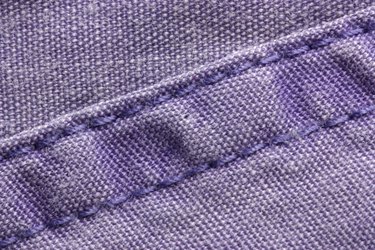
Whether you're mending a tear, hemming a gown or designing a whole collection, sewing is the craft that binds these activities together. Sewing is done by hand or through the use of a machine. Edge stitching -- also known as topstitching -- is primarily a machine-stitch that is sewn close to the edge of a garment in a visible and decorative style. Though edge stitching by hand is possible, the power and precision of a machine generates the best results.
Description
Video of the Day
Edge stitching is a visible line of stitching that is sewn very close to the edge of a garment, such as the pockets of jeans. Typically, edge stitching is made about 1/4-inch from the edge of the garment and is used in a specific design area instead of on the entire garment. Edge stitching can appear in single or multiple lines, and in addition to pockets, is often found on collars and lapels.
Video of the Day
Thread
Because edge stitching is done with a machine, the design detail tends to be more prominent because the machine uses a heavier thread weight than is typically available with hand sewing. For optimal results, 90/14 or 100/16 needles, which feature large eyes for thick threads to pass through are ideal. This prevents the thread from shearing or breaking. Edge stitching thread is available in standard colors, and is also offered in fabric such as silk, for more delicate garments.
Sewing Techniques
Depending on the kind of sewing machine you own, several methods exist for effective edge stitching. If your sewing machine has a triple stitch option, this is the easiest and most effective way to edge stitch. A triple stitch is one in which the sewing machine makes one forward stitch, one backward stitch and another forward stitch. This helps to reinforce the stitching and enhance its decorative appearance. If you use a normal straight stitch, pass over the stitch several times to achieve the same effect. You can also place two threads in the machine's needle for a thicker and more prominent edge stitch line.
Tips
Because edge stitching creates prominent and visible lines, you have to ensure that each line is kept straight when it's threaded through the sewing machine. Many machines feature a presser foot, a device that presses on a garment and feeds it through the machine. Line up the edge of the presser foot to edge of the fabric you are stitching to keep the stitch line straight. And remember that edge stitching requires you to sew on the visible side of a garment or fabric because it's meant to be seen as a decorative style.